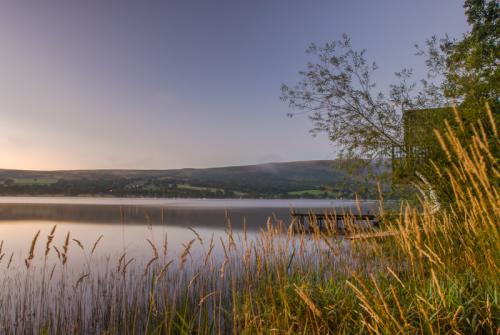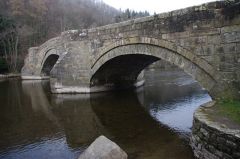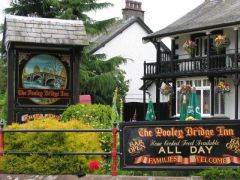
Pooley Bridge is a popular village at the northern terminus of the Ullswater Lake Steamer route. There are walking trails along the shore of Ullswater, and nearby are the remains of a prehistoric hill fort.
The village name means 'hill by the pool' and comes from a large pool in the River Eamont and Dunmallet, or Dunmallard, a conical hill that rises on the far side of the river. The 'bridge' comes from the late 18th-century bridge across the river. The 3-arch bridge was erected in 1764, according to an inscription on a parapet stone. It replaces a much earlier bridge dating back to the late 16th century.
The village is very popular with tourists, especially during the summer months. As a result, there are several hotels and inns, including the Sun Inn, created from a row of 17th-century cottages.
St Paul's church was built in 1868 as a daughter church of St Michael's in nearby Barton. It was felt that a new church was needed in Pooley Bridge to deal with the large numbers of tourists flocking to the area in the late Victorian period. Pooley Bridge did not become a parish in its own right until 1905 and still maintains close links with Barton.
There is an Iron Age fort on the summit of Dunmallet and a circular earthwork fort at Maiden Castle (not to be confused with the much larger site in Dorset). The Maiden Castle site is in a farm field at grid reference NY452243, a mile west of the village. As for Dunmallet, it can be reached via a footpath from the far side of the bridge. The walk is described by Alfred Wainwright in his book The Outlying Fells of Lakeland, as a 'simple after-dinner stroll'.
About Pooley Bridge
Address: Pooley Bridge,
Lake District,
Cumbria,
England
Attraction Type: Village
Location: On the B5320 at the northern end of Ullswater
Location map
OS: NY470245
Photo Credit: David Ross and Britain Express
POPULAR POSTS
HERITAGE
 We've 'tagged' this attraction information to help you find related historic attractions and learn more about major time periods mentioned.
We've 'tagged' this attraction information to help you find related historic attractions and learn more about major time periods mentioned.
Historic Time Periods:
Find other attractions tagged with:
16th century (Time Period) - 17th century (Time Period) - 18th century (Time Period) - castle (Architecture) - hill fort (Historical Reference) - Iron Age (Architecture) - Prehistoric (Time Period) - Victorian (Time Period) -
NEARBY HISTORIC ATTRACTIONS
Heritage Rated from 1- 5 (low to exceptional) on historic interest
Dacre, St Andrews Church - 1.4 miles (Historic Church) ![]()
Dalemain - 1.5 miles (Historic House) ![]()
Ullswater - 3 miles (Countryside) ![]()
Lowther Castle and Gardens - 3.3 miles (Historic House) ![]()
Mayburgh Henge - 3.9 miles (Prehistoric Site) ![]()
King Arthur's Round Table - 4 miles (Prehistoric Site) ![]()
Clifton Hall - 4.2 miles (Historic Building) ![]()
Penrith Castle - 4.3 miles (Castle) ![]()









